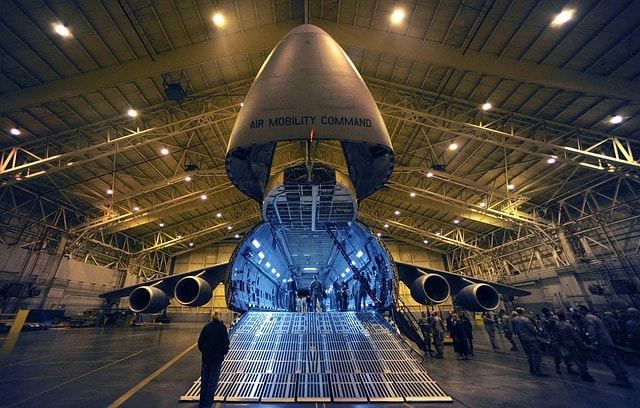Selecting the right hangar door is key to ensuring safety and efficiency in your aviation facility. This article delves into the main types of hangar doors—sliding, bottom rolling, hydraulic, and bifold—highlighting their key features and advantages. By the end, you’ll have a clear understanding of which hangar door best fits your specific needs.
Key Takeaways
- Modern aircraft hangar doors offer various options like bottom rolling, bifold, sliding, hydraulic, and customizable features to enhance safety, efficiency, and accessibility.
- Key advancements include smart technology for remote monitoring, improved insulation for energy efficiency, and weather resistance to protect valuable aircraft.
- Proper installation and maintenance are essential for durability, with professional services maximizing performance and reducing operational issues over time.
Aircraft Hangar Doors Overview
Aircraft hangar doors play a crucial role in protecting valuable assets, including both the facilities and the aircraft housed within them. These doors are designed to accommodate various types of aircraft, from helicopters to large commercial airplanes, ensuring that each craft is safely sheltered and easily accessible. Choosing the right hangar door ensures effective aircraft operation, safety, facility efficiency, and the proper use of aircraft hangars.
There are several types of hangar doors available, each offering unique advantages:
- Bottom rolling doors: Perfect for large aircraft due to their significant weight capacity.
- Bifold doors: Favored for their space-saving vertical opening mechanism.
- Hydraulic doors: Known for robust performance in adverse weather conditions and quick access capabilities.
Customization is another vital aspect of modern hangar doors. Whether it’s a commercial aviation hangar, a helicopter base, or a maintenance, repair, and overhaul (MRO) facility, hangar doors can be tailored to meet specific requirements, ensuring optimal performance and convenience. Manufacturers like Thermostop offer specialized solutions that cater to both aircraft and industrial settings, enhancing the overall utility and efficiency of the facility.
Sliding Hangar Doors
Sliding hangar doors are a popular choice for many aviation facilities due to their straightforward design and operational efficiency. These doors function by moving horizontally on tracks, which allows for various configurations based on size requirements. This flexibility makes them suitable for a wide range of applications, from small helicopter hangars to large airplane storage facilities. One of the key advantages of sliding hangar doors is that they require less headroom compared to other types, making them ideal for facilities with height restrictions.
However, it’s important to note that manual operation of sliding doors can be strenuous unless they are motorized. Despite this, they remain a cost-effective option to manufacture and install compared to other door types.
Custom designs can accommodate existing structures and specific operational needs, ensuring that the sliding doors integrate seamlessly with the facility’s overall design. Brands like Champion Door and Schweiss Doors are renowned for their high-quality sliding hangar doors, offering durable and reliable solutions for various aviation needs.
Bottom Rolling Hangar Doors
Bottom rolling hangar doors are engineered for heavy industrial use, offering long-lasting performance and reliability. These doors are designed to handle significant weight, making them ideal for large aircraft types that require robust and durable door systems. Whether for new construction or retrofitting existing structures, bottom rolling hangar doors can be customized in size and configuration to meet the specific needs of the facility.
One of the standout features of bottom rolling hangar doors is their competitive pricing and value, providing an economical solution without compromising on quality. Using Hercul-Eze Hangar Door Operators, specifically designed for bottom rolling doors, ensures optimal performance. These operators enhance the functionality and longevity of the doors, making them a wise investment for any aviation facility.
Hydraulic Hangar Doors
Hydraulic hangar doors are known for their strength and reliability, particularly in adverse weather conditions. These doors must possess the structural integrity to withstand forces exerted during high winds events, making them a robust choice for facilities in regions prone to extreme weather. Equipped with heavy-duty hydraulic pumps, these doors can operate smoothly even during strong winds, ensuring the safety and security of the aircraft inside.
One of the key advantages of hydraulic hangar doors is their quick access feature, which is crucial for the rapid departure of aircraft in emergencies. Their design allows for large openings, making them suitable for a variety of aircraft sizes and types.
Brands like Schweiss Doors have perfected the engineering of hydraulic hangar doors, providing reliable and efficient solutions that meet the high demands of modern aviation facilities.
Bifold Hangar Doors
Bifold hangar doors are designed with patented technology that enhances their functionality and reliability. These doors feature strap latches that secure them in the open position, providing stability during operation and protection from wind gusts. The vertical opening mechanism of bifold doors maximizes space and allows for greater clearance, making them a popular choice in both aviation and industrial settings. Additionally, the hinges used in these doors contribute to their overall performance.
The ease of installation and operation of bifold doors adds to their appeal, as they can be easily integrated into various facilities. Before delivery, these doors undergo thorough checks to ensure smooth installation and perfect operation. Customization options include adding windows and personnel doors, enhancing both the aesthetic appeal and functionality of the hangar.
Key Features of Modern Hangar Doors

Modern hangar doors are equipped with a range of features that enhance their functionality and efficiency, including:
- Quicker opening times, which significantly improve operational efficiency for busy aviation facilities
- Fully automatic operation, providing convenience and ease of use for operators
- Reliability and cost-effectiveness, ensuring long-term value
Smart door technology has revolutionized the way hangar doors are managed. Key aspects include:
- Remote monitoring and management, allowing operators to control the doors from a distance and receive real-time updates on door conditions.
- Common components such as hydraulic cylinders and electric motors that ensure smooth operation.
- Regular cleaning and lubrication necessary to maintain functionality.
- Functional tests performed to verify safety features and operational speed, ensuring the doors meet the highest standards of performance.
Additionally, modern hangar doors are designed to be lightweight, which contributes to space-saving benefits and ease of installation. The combination of these features makes modern hangar doors an indispensable asset for any aviation facility.
Insulation and Energy Efficiency
Insulation is a critical feature of modern hangar doors, significantly impacting energy efficiency and indoor climate control. High-quality insulation properties help maintain temperature control within the hangar, improving the overall indoor climate and preventing pests from entering. By effectively sealing against environmental elements, insulated hangar doors can lower energy costs, making them a cost-effective solution for facilities.
Customers often praise Schweiss doors for their excellent insulation, which enhances energy efficiency and contributes to the overall sustainability of the facility. The insulation options for hangar doors can be tailored to meet different energy efficiency standards, ensuring that each facility can optimize its energy use.
Constructed from materials like steel, aluminum, and fiberglass, these manufactured doors are built to offer high durability and resistance to environmental factors.
Wind and Weather Resistance
Modern hangar doors are engineered to withstand a variety of harsh weather conditions, including dirt, wind, snow, dust, and extreme temperatures. Thermostop hangar doors, for example, are specifically designed to endure such challenging environments. This resilience is crucial for facilities located in areas with severe weather, ensuring the protection of valuable aircraft inside the hangar.
The new design of automatic strap latches holds the door securely in all positions, protecting against wind gusts and ensuring operational efficiency even in high wind conditions. Customers have expressed satisfaction with the performance of these doors, particularly in harsh weather conditions, highlighting their reliability and durability.
Safety and Security
Safety and security are paramount when it comes to hangar doors. Hydraulic doors, for instance, can often be equipped with safety features that allow them to remain functional during power outages. Integrated safety features such as auto-reverse sensors prevent accidents during operation, ensuring the protection of both aircraft and personnel.
Customization options may include different operational mechanisms and specialized features tailored to specific uses, enhancing both convenience and efficiency. The combination of these safety and security features ensures that modern hangar doors meet the highest standards of protection, reliability, model performance, and specifications.
Customization Options for Hangar Doors
Customization is a significant advantage of modern hangar doors, allowing facilities to tailor their door systems to meet specific operational needs. From smart features and customizable sizes to various configurations, these options ensure that each hangar door performs optimally for its intended use. Tilt hydraulic doors, for instance, offer a wide range of customization options and modifications, making them a versatile choice for different facilities.
The ability to customize hangar doors not only enhances their functionality but also ensures that they blend seamlessly with the overall design of the facility. Whether it’s for a commercial aviation hangar, a helicopter base, or an industrial setting, customization options provide the flexibility needed to adjust to diverse requirements.
Materials and Construction
Hangar doors are constructed using a variety of materials to fulfill specific needs and improve functionality. Premium materials such as rib panels and foam panels are commonly used in the construction of hangar doors, offering durability and structural integrity. These materials ensure that the doors can withstand the demands of daily operation and exposure to environmental factors.
The choice of materials can significantly impact the performance and longevity of the hangar doors. For instance, steel, aluminum, and fiberglass each offer distinct advantages in terms of cost, weight, and durability, allowing facilities to select the best option based on their specific requirements.
Size and Configuration
Customization in the size and configuration of hangar doors allows facilities to cater to the specific needs of different aircraft types. Hangar doors can be customized in size to accommodate various types of aircraft, providing greater flexibility in hangar design. This flexibility is particularly important for facilities that house a diverse range of aircraft, ensuring that each door system can be tailored to meet specific operational needs.
Bifold hangar doors, for example, are designed to open vertically, which maximizes space and allows for greater clearance. This design feature is beneficial for facilities with limited space, as it optimizes the available area and enhances overall efficiency.
Color and Aesthetics
Hangar doors can be finished in a variety of colors and textures, enabling them to blend with the overall architectural style of the facility. Customization includes a variety of color palettes and finishes that align with the overall design, enhancing the aesthetic appeal of the hangar.
These aesthetic options not only improve the visual appeal of the facility but also contribute to its overall branding and identity. High-quality finishes and attention to detail ensure that the hangar doors stand out as a prominent feature of the building.
Maintenance and Durability of Hangar Doors
The durability of hangar doors is crucial for their performance, especially given their exposure to weather and operational demands. Many hydraulic hangar doors are constructed with materials that resist corrosion, ensuring longevity even in harsh environments. Regular maintenance is essential to prevent operational issues and extend the lifespan of the doors.
Maintenance practices typically involve inspecting components such as:
- cables
- springs
- electrical systems for wear or damage. Comprehensive inspections can identify necessary replacements for operator and hardware components, ensuring that the limits of the doors remain in optimal condition.
Regular cleaning and lubrication are also necessary to ensure smooth operation.
Installation and Retrofit Services
Installation is a critical phase for ensuring the optimal performance of hangar doors. Professional services are available to handle the installation process, which involves setting rails into footings to ensure stability and functionality. These services are crucial for both new installations and retrofit projects, ensuring that the hangar doors are installed correctly and efficiently.
The ease of installation provided by manufacturing manufacturers like Schweiss is often highlighted by users, who appreciate the clarity of the instructions and the support provided. Upgrading existing systems, such as converting manually operated doors to fully automated versions, can significantly enhance the functionality and convenience of the facility.
Enlisting professional services ensures comprehensive maintenance and adherence to safety standards, providing peace of mind to facility managers in the world and helping to protect their interests.
Customer Testimonials
Customer feedback is a testament to the quality and functionality of modern hangar doors. Many users have praised the quick operation speed of Schweiss doors, which is particularly advantageous for facilities with high-traffic needs. The remote operation feature is another highlight, offering convenience by allowing users to control the doors from a distance.
Clients have shared positive experiences of using Schweiss doors in unique applications, including large-scale commercial installations. The exceptional build quality and design team often stand out as the main project feature of their properties.
Reliable customer service is frequently mentioned, with customers appreciating the prompt responses and helpful assistance during the installation process. Such testimonials underscore the value and expertise that Schweiss brings to the market, making their doors a preferred choice for many in the aviation industry.
Summary
In summary, choosing the right hangar door solution is crucial for the effective operation and safety of aircraft facilities. From sliding and bottom rolling doors to hydraulic and bifold variants, each type offers unique advantages tailored to specific requirements. Modern hangar doors are equipped with advanced features that enhance insulation, weather resistance, and security, ensuring the protection of valuable assets.
Customization options allow for tailored solutions that meet the specific needs of different facilities, while regular maintenance and professional installation services ensure long-term durability and performance. Customer testimonials highlight the exceptional quality and functionality of leading brands like Schweiss, reinforcing their reputation in the market. With the right hangar door solution, aviation facilities can achieve operational efficiency, safety, and reliability, safeguarding their valuable aircraft and enhancing overall performance.
Frequently Asked Questions
What are the main types of aircraft hangar doors available?
The main types of aircraft hangar doors are sliding, bottom rolling, hydraulic, and bifold, each with distinct advantages suited for various operational needs. Selecting the right type is crucial for optimizing accessibility and efficiency.
How do hydraulic hangar doors perform in extreme weather conditions?
Hydraulic hangar doors are engineered to operate reliably in extreme weather, including high winds, thanks to their robust hydraulic pumps. This design ensures their performance remains consistent and secure under challenging conditions.
What customization options are available for hangar doors?
Hangar doors can be customized in size, configuration, material, and aesthetic finishes, enabling facilities to meet specific operational requirements and design preferences effectively.
How important is regular maintenance for hangar doors?
Regular maintenance is essential for the durability and optimal performance of hangar doors. By regularly inspecting, cleaning, lubricating, and replacing worn parts, you can prevent operational issues and extend the lifespan of the doors.
What do customers say about Schweiss hangar doors?
Customers consistently highlight Schweiss hangar doors for their fast operation, convenience of remote control, high-quality construction, and dependable customer service, establishing them as a top choice in aviation.




